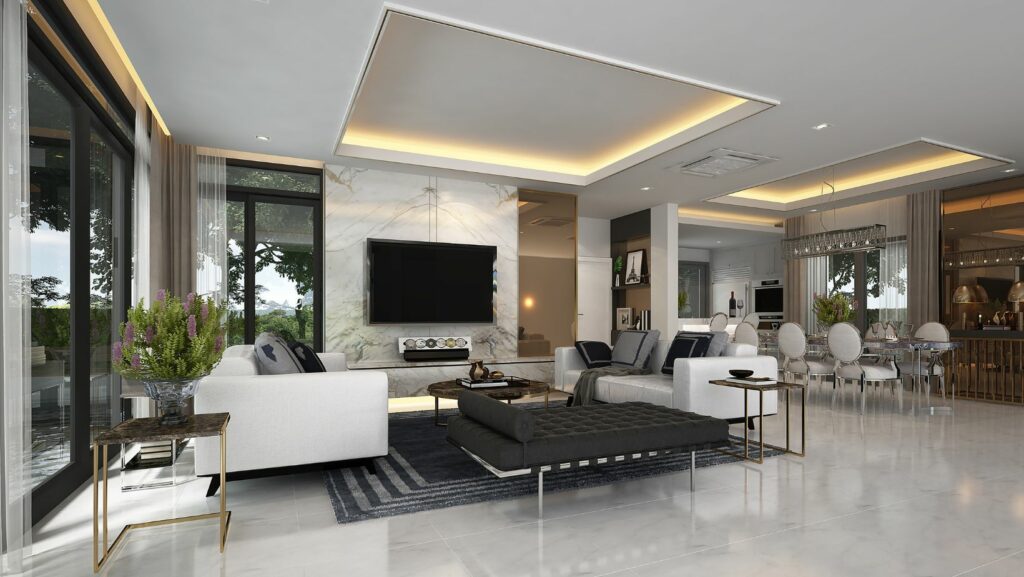Can your home or office design help the planet? Is it possible for beautiful interiors to also be environmentally responsible? These are the questions driving a shift in how we think about architectural interior design. As environmental concerns take centre stage across industries, designers, architects, and consumers alike are recognising the importance of creating indoor spaces that are not only aesthetically pleasing but also sustainable. Sustainable interior design isn’t just about choosing eco-friendly materials—it involves a holistic approach that considers the lifecycle of every element within a space.
Why Sustainability Matters in Interior Spaces
Buildings are among the largest contributors to global carbon emissions, and interior design plays a crucial role in reducing that impact. From lighting and materials to air quality and energy consumption, decisions made during the design process can significantly influence a building’s ecological footprint. Sustainable interior design aims to create spaces that promote wellbeing, conserve resources, and reduce waste—while still meeting the functional and visual needs of their users.
Sustainable Materials and Finishes
One of the most visible aspects of sustainable interior design is the selection of materials. Designers are increasingly opting for reclaimed wood, recycled metal, bamboo, cork, and other low-impact materials. These choices not only reduce demand for virgin resources but often bring unique textures and warmth to spaces.
Low-VOC (volatile organic compound) paints and finishes have also gained popularity. Traditional products can release harmful chemicals into the air, affecting indoor air quality. Sustainable alternatives contribute to healthier indoor environments, which is particularly important in residential, office, and educational settings where people spend most of their time indoors.
Fabrics and textiles are also being reimagined. Organic cotton, hemp, and recycled polyester are becoming staples in upholstery and curtains, offering comfort without the environmental burden of synthetic or non-renewable materials.
Energy Efficiency and Smart Design
Sustainable interior design isn’t limited to material selection—it also encompasses energy use. Smart design strategies such as maximising natural light, improving insulation, and choosing energy-efficient appliances contribute to reduced electricity consumption.
Strategic space planning can also enhance sustainability. For example, flexible layouts that allow a room to serve multiple functions reduce the need for extra square footage and materials. Integrated smart systems—such as motion-sensor lighting or intelligent climate control—can drastically reduce wasted energy and improve overall efficiency.
Lighting, in particular, is a key component. Replacing traditional incandescent bulbs with LED fixtures can dramatically cut energy usage. In addition, placing light sources strategically to enhance daylight can reduce dependence on artificial lighting.
Reuse and Adaptive Reuse
The most sustainable option is often the one that already exists. Adaptive reuse—repurposing buildings or interior elements rather than demolishing and rebuilding—is an increasingly popular approach in sustainable design. It not only preserves architectural heritage but also reduces the environmental impact associated with new construction.

Designers are also finding creative ways to repurpose existing furniture, fixtures, and materials. Vintage pieces can be updated or reupholstered to suit modern tastes, keeping them out of landfills and extending their life cycles. This approach ties in with the broader concept of the circular economy, in which materials are reused and recycled rather than discarded. This is especially relevant in sectors like luxury interior design in London, where combining sustainability with elegance and heritage is becoming a signature of thoughtful, forward-thinking design.
Wellbeing and Biophilic Design
A truly sustainable space also supports the health and wellbeing of its occupants. Biophilic design—an approach that incorporates natural elements into interior spaces—has been linked to improved mental health, productivity, and satisfaction. Features such as indoor plants, natural lighting, ventilation, and water elements can bring nature indoors and foster a calming, rejuvenating environment.
Designers are increasingly aware that sustainability and wellness go hand in hand. A well-ventilated space with non-toxic materials, good acoustics, and thoughtful lighting is not just environmentally responsible—it’s also more pleasant and healthier to inhabit.
Certification and Accountability
Green building certifications such as LEED (Leadership in Energy and Environmental Design), WELL, and BREEAM encourage transparency and accountability in sustainable interior design. These frameworks provide measurable criteria for energy efficiency, materials, indoor environmental quality, and more.
While not every project needs certification, these guidelines help set industry benchmarks and motivate designers and clients to prioritise sustainability throughout the design process.
The Role of Technology
Modern technology is playing a major role in advancing sustainable interior design. Digital tools allow designers to model energy performance, material sourcing, and carbon footprint with precision. 3D modelling, augmented reality, and virtual walkthroughs enable clients to visualise designs before construction begins—reducing waste and rework.
Additionally, smart home technology makes it easier to monitor and manage energy use, lighting, and air quality in real time. These systems contribute not just to sustainability goals but also to overall comfort and user experience.
Conclusion: Designing for the Future
Sustainability in architectural interior design is more than a trend—it’s a responsibility. As climate change and environmental degradation continue to challenge our planet, every industry must rethink its practices. Interior design offers a unique opportunity to merge form, function, and environmental consciousness in spaces where people live, work, and play.

By embracing sustainable materials, energy-efficient systems, and thoughtful planning, interior designers can shape environments that are both beautiful and beneficial. In doing so, they help pave the way for a greener, healthier future—one room at a time.

